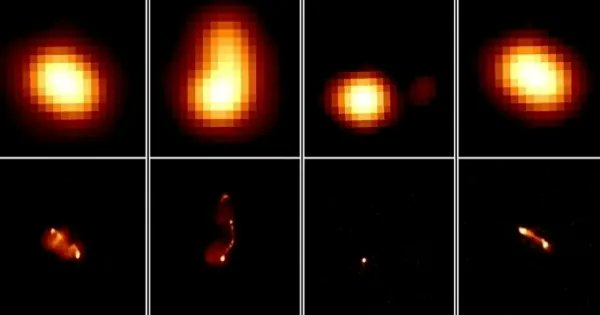With better computers comes more battery imagery. Or at least that’s true most of the time. Supercomputers are extraordinarily good at image processing, so it’s normally worth it when a new algorithm comes along that they can turn their attention to. That’s exactly what happened with an algorithm recently developed by Ph.D. student Frits Sweijen and his colleagues at Leiden University. They used several supercomputers’ image processing power to simulate and enhance the resolution of radio images captured by the International LOFAR telescope.
Mr. Sweijen and his team used their algorithm to solve a particularly thorny problem in radio astronomy – how to filter out noise from our atmosphere. The sun charges the Earth’s atmosphere with particles that interfere with radio signals, making it difficult to capture a clear picture of the radio-emitting phenomena with ground-based radio telescopes.

Credit – Leiden University / Sweijen et al.
That’s where the algorithm comes in. It uses statistical signal processing techniques to correct for radiation caused by the sun, allowing it to be removed from the data LOFAR collected. To do this required a lot of processing power, for which the team turned to supercomputers.
They utilized the Academic Leiden Interdisciplinary Cluster Environment (ALICE) and Spider supercomputing platforms to parallelize the calculations that resulted in much higher resolution images that had previously been available. The resolution was so high, in fact, that one section, which was an area about the size of a full moon, would have as many pixels in it as a normal radio map of the complete sky.

Credit: ASTRON/LOFAR.
Such a pretty significant improvement did come at the cost of 7 days running on those parallel supercomputing clusters to complete 25 full moon’s worth of the sky. But realistically, that is not that much time. Theoretically, the team expects to complete a map for the entire northern hemisphere, which is where LOFAR is located. Whether or that scalability will work remains to be seen. But with battery imagery also comes better science.
Learn More:
Leiden University – A much sharper picture of the universe with new algorithms and supercomputers
Leiden University – Ultra-sensitive radio images reveal thousands of star-forming galaxies in early Universe
Space.com – Epic radio images give most-detailed views of distant galaxies
UT – LOFAR Sees Strange Radio Signals Hinting at Hidden Exoplanets

